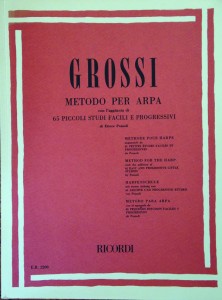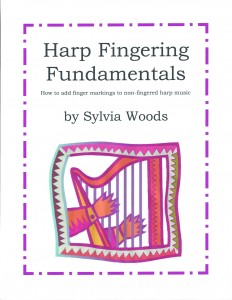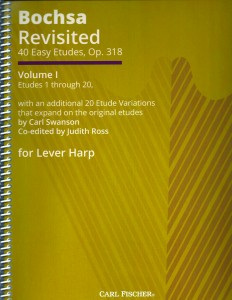There are several new publications that both teachers and students will find very useful, but first let’s consider an old standard for harp technique basics that will give some context for these new offerings.

The Grossi Method for the Harp is still one of the best books out there for developing technique. The book is organized into several sections. There are some wonderful photos of hand positions followed by exercises presented in a logical, progressive fashion. These introduce concepts such as preparing for arpeggios, superimposing the two hands, stretching the second and third fingers, preparing for chords, how to play octaves, scales, harmonics, and much more. This is followed by 20 grade one and then 45 grade two etudes by Pozzoli.
With the exception of the last five etudes, all the material is entirely diatonic and in the key of C, making it useful for both pedal and lever harpists. Anyone who masters the material presented in this book will have a solid foundation in technique. However, since the text is entirely in Italian, it is most effective when used under the guidance of a qualified teacher. Even without a translation, a good teacher can point out the reasoning behind the fingering options as well as assign the etudes when the student has learned the basic skills required to play them.

But not all students have access to a qualified teacher, and even those who do may appreciate a book that covers all the basics of fingering. Sylvia Woods has come to the rescue with a superb reference, Harp Fingering Fundamentals, which explains in detail how to choose fingering that works for you. There are 55 pages plus two appendices that explain crossing over and under, slides, and muffling.
First, she reassures us that there is rarely only one choice for fingering. Next, she gives us some general rules for fingering of intervals. She explains the factors that can affect our choices, keeping in mind the importance of phrasing. She suggests ways to minimize buzzing. Best of all, she offers numerous examples and options.
After her detailed explanation of fingering options, Ms. Woods provides 11 lead sheets of mostly folk songs to use as a workbook and fill in your own fingering. Then she presents them again with the fingering she would choose so that you can compare. She explains how she arrived at her choices and provides references back to the rules she explained earlier in the book. This is an amazingly thorough and informative book. Add it to your library right next to the Grossi book.

After mastering fingerings and beginner etudes thanks to the Woods and Grossi books, there are plenty of options for more advanced etudes for pedal harp (e.g. the Pozzoli Etudes of Medium Difficulty), but they are harder to find for lever harp. Carl Fischer has published Volume 1 of some Bochsa etudes, entitled Bochsa Revisited, 40 Easy Etudes, Op. 318. There is one edition for lever harp tuned to E-flat, and one edition for pedal harp. There are 20 etudes in Volume 1, and they have been edited by Carl Swanson and Judith Ross.
In addition to the edits, Mr. Swanson has written wonderful variations for each of the 20 etudes. As he points out in the preface, many of the original etudes focused primarily on the right hand and were written in the middle octaves of the harp. His variations cover a wider range of the instrument and provide more workouts for the left hand. In general, his variations are slightly more difficult than the original etude.

There are only minor differences between the pedal and lever harp books. In measures 9–12 of Etude V, for example, Mr. Swanson takes the scales that are in the left hand in the pedal version and switches them to the right hand in the lever version to allow the left hand to move levers. He does this whenever necessary throughout the book. Occasionally, an accidental is simply eliminated in the lever version. There is an error in the lever version of Etude V, measure 20, where the last note in the left hand should be an A as it is in the pedal version.
Mr. Swanson provides a plethora of good advice in the preface including a discussion of the importance of etudes, how to practice, how to play with even tone, and developing good rhythm. He also provides synopses of all the etudes and variations, explaining the technical points of each one.
It is important to note that despite the title of the book, these etudes are not easy. For example, Etude III requires the placing of all four fingers and then playing 1 and 3 together and then 2 and 4 together or vice versa. It also requires the two hands to play these patterns in opposite directions at the same time. This is not easy for beginners. The harpist must be able to play scales, octaves, large chords, and have finger independence to able to play these pieces. However, this book is an excellent place to go after completing the Grossi book.
The typesetting of this spiral-bound book is beautiful and each piece is just two pages. Fingering is provided in places where it is needed, and it is large and easy to read. There are a few places where more suggested fingering would be helpful. In the pedal harp version, pedal changes are written where space permits, either between the staves or below the staff. Lever changes are indicated by large, diamond-shaped notes, and the music has been thoughtfully planned to free the left hand for making changes.
A few of these Bochsa etudes are already on the ABRSM syllabus for pedal harp in Grades three, four, and five. Hopefully, this new book edited for lever harp and Swanson’s variations in both books will be added to the ABRSM repertoire. •







